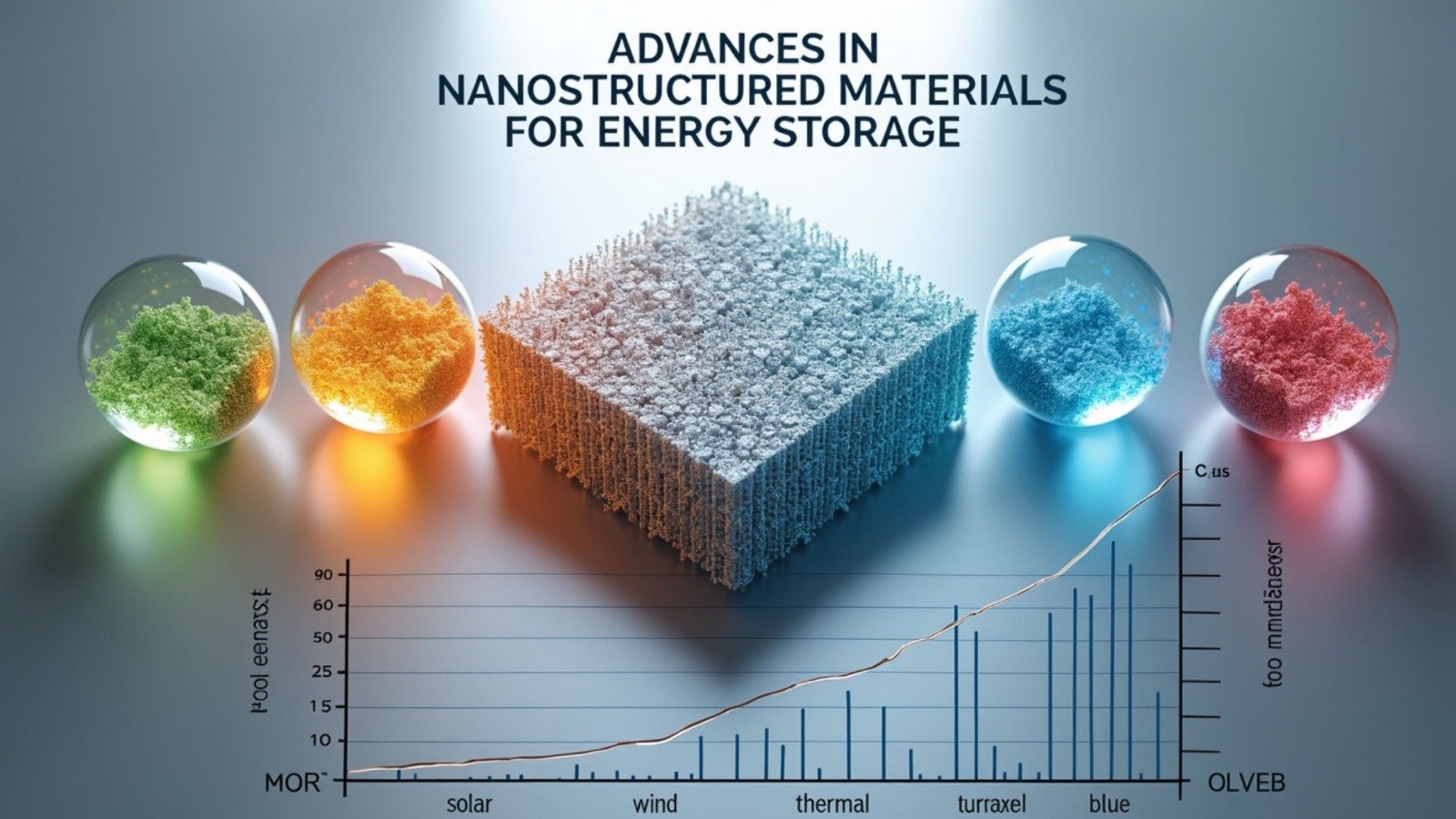
Advances in Nanostructured Materials for Energy Storage
- by phdblog
1. Introduction
The demand for efficient, sustainable, and scalable energy storage systems is at an all-time high, driven by the rapid adoption of renewable energy technologies and the proliferation of portable electronics and electric vehicles. At the forefront of innovation are nanostructured materials, which offer unprecedented opportunities to enhance the performance, efficiency, and lifespan of energy storage devices (Gidiagba et al., 2023). This blog explores recent advances in nanostructured materials and their transformative impact on energy storage technologies.
2. The Role of Nanostructured Materials in Energy Storage
Nanostructured materials have unique properties that stem from their nanoscale dimensions (1–100 nm) (Sun et al., 2020). These materials exhibit high surface area-to-volume ratios, tunable electronic properties, and superior mechanical strength, making them ideal candidates for energy storage applications. In batteries, supercapacitors, and fuel cells, nanostructured materials can enhance ion transport, increase charge storage capacity, and improve energy efficiency.
3. Breakthroughs in Nanostructured Materials
3.1 Nanostructured Cathode Materials for Lithium-Ion Batteries
Lithium-ion batteries (LIBs) remain the cornerstone of modern energy storage, powering everything from smartphones to electric vehicles (Jose et al., 2024). Advances in nanostructured cathodes, such as lithium iron phosphate (LFP) and layered transition metal oxides, have significantly improved energy density and cycle life. For instance, nanostructured LFP particles enable faster lithium-ion diffusion and higher conductivity, addressing issues of slow charging and thermal instability.
3.2 Nanostructured Anode Materials for Next-Generation Batteries
Silicon-based anodes have gained attention due to their high theoretical capacity, which is ten times greater than traditional graphite anodes. However, their tendency to expand and fracture during charge-discharge cycles has been a major bottleneck. Nanostructuring silicon into nanoparticles or nanowires has mitigated these issues by accommodating volume changes and enhancing structural integrity.
3.3 Nanomaterials in Solid-State Batteries
Solid-state batteries are emerging as a safer and more energy-dense alternative to LIBs. The incorporation of nanostructured solid electrolytes, such as garnet-based and sulfide-based materials, improves ionic conductivity and stability at interfaces (Paul et al., 2022). This paves the way for solid-state batteries that are less flammable and capable of delivering higher energy densities.
3.4 Graphene-Based Supercapacitors
Supercapacitors are valued for their high-power density and fast charging capabilities. Graphene, a two-dimensional nanomaterial, has revolutionized supercapacitor electrodes (Panda et al., 2020). Its exceptional electrical conductivity and surface area enhance energy storage while maintaining durability over thousands of cycles. Emerging hybrid structures combining graphene with metal oxides or conducting polymers have further amplified the energy density of supercapacitors.
3.5 Nanostructured Materials for Sodium-Ion and Beyond-Lithium Batteries
To reduce dependence on lithium resources, sodium-ion batteries (SIBs) have gained traction. Nanostructured materials, such as sodium vanadium phosphate and carbon-based nanostructures, offer improved charge storage and faster ion diffusion. Similarly, for beyond-lithium technologies like magnesium-ion and zinc-ion batteries, nanostructured cathodes and anodes play a pivotal role in enhancing performance.
4. Challenges and Opportunities
Despite remarkable progress, challenges remain in scaling up nanostructured materials for commercial applications. Some of the key hurdles include:
Cost and Scalability: The synthesis of nanostructured materials often involves complex and expensive processes, hindering large-scale production.
Durability and Stability: Prolonged cycling can degrade nanostructures, affecting the reliability and lifespan of energy storage devices.
Environmental Impact: The production and disposal of nanomaterials raise concerns about their ecological footprint.
Addressing these challenges requires a multidisciplinary approach, leveraging advancements in nanotechnology, materials science, and process engineering. Emerging fabrication techniques, such as atomic layer deposition (ALD) and 3D printing, are making it possible to manufacture nanostructured materials at lower costs and with higher precision (Zhang et al., 2022).
5. Future Prospects
The future of energy storage lies in the integration of nanostructured materials with cutting-edge technologies. For instance:
Hybrid Systems: Combining batteries and supercapacitors with nanostructured materials can achieve an optimal balance of energy density and power density.
AI-Driven Material Design: Artificial intelligence is revolutionizing the discovery of new nanostructured materials by predicting properties and optimizing compositions.
Sustainable Nanomaterials: Research is focusing on renewable and biodegradable nanostructured materials to reduce environmental impact.
Additionally, the integration of nanostructured materials into emerging energy storage platforms like flow batteries and hydrogen storage systems holds immense potential for large-scale energy applications.
6. Conclusion
Nanostructured materials are redefining the landscape of energy storage technologies, enabling devices that are faster, safer, and more efficient. From enhancing lithium-ion batteries to pioneering solid-state systems, these materials offer solutions to some of the most pressing energy challenges of our time. As research continues to evolve, the synergy between nanotechnology and energy storage will play a pivotal role in powering a sustainable and electrified future.
7. References
Gidiagba, J. O., Daraojimba, C., Ofonagoro, K. A., Eyo-Udo, N. L., Egbokhaebho, B. A., Ogunjobi, O. A., & Banso, A. A. (2023). Economic impacts and innovations in materials science: a holistic exploration of nanotechnology and advanced materials. Engineering Science & Technology Journal, 4(3), 84-100.
Jose, S. A., Stoll, J. L., Smith, T., Jackson, C., Dieleman, T., Leath, E., … & Menezes, P. L. (2024). Critical Review of Lithium Recovery Methods: Advancements, Challenges, and Future Directions. Processes, 12(10), 2203.
Panda, P. K., Grigoriev, A., Mishra, Y. K., & Ahuja, R. (2020). Progress in supercapacitors: roles of two dimensional nanotubular materials. Nanoscale Advances, 2(1), 70-108.
Paul, P. P., Chen, B. R., Langevin, S. A., Dufek, E. J., Weker, J. N., & Ko, J. S. (2022). Interfaces in all solid state Li-metal batteries: a review on instabilities, stabilization strategies, and scalability. Energy Storage Materials, 45, 969-1001.
Sun, L. G., Wu, G., Wang, Q., & Lu, J. (2020). Nanostructural metallic materials: Structures and mechanical properties. Materials Today, 38, 114-135.
Zhang, J., Li, Y., Cao, K., & Chen, R. (2022). Advances in atomic layer deposition. Nanomanufacturing and Metrology, 5(3), 191-208.
1. Introduction The demand for efficient, sustainable, and scalable energy storage systems is at an all-time high, driven by the rapid adoption of renewable energy technologies and the proliferation of portable electronics and electric vehicles. At the forefront of innovation are nanostructured materials, which offer unprecedented opportunities to enhance the performance, efficiency, and lifespan of…
